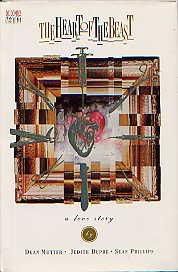Motter, Dean: The Heart of the Beast

The Heart of the Beast (1994)
Written by: Dean Motter & Judith Dupré
Illustrator: Sean Phillips
Genre: Graphic Novel
Pages: 96 (Hardcover)
For those of you who are fans of Mary Shelley's Frankenstein, this is a review/graphic novel you don't want to miss.
Like me, my husband has been wanting to re-read Frankenstein. Unlike me, he finished reading it and dug up this graphic novel he's had for a while and re-read that. Why? Let's just say that The Heart of the Beast is a great sequel to Frankenstein without actually being a sequel to the book. He made me read it, which didn't take long at all, given the length, and I decided to make sure sure all of you were aware of this little gem, especially if you're not in the graphic novel loop, especially since Frankenstein was our October Challenge. Consider this book to be . . . let's say . . . extra credit!
This won't be a usual review, mostly because of the format and the fact there's not a lot to SAY without spoiling the book completely. So I'll say a few things, and that'll be that. I'm not even going to RATE the sucker because 1) I never bought it to begin with and 2) I really don't buy graphic novels, so you don't have a good base for comparison, you know?
The Heart of the Beast was written back in the mid-nineties, and this is important for a couple of reasons. For starters, it'll put the cultural look in context, but more important, it'll put social issues in context. The big social issue to be aware of? AIDS/HIV. Stupid me kept forgetting that THIS was the thing that scared the living hell out of everyone at the time (even though growing up, I heard all about it), and that made me miss a few obvious things in the graphic novel. So, remember that. AIDS/HIV was a BIG FEAR back in that day, and that fear colors the pages, both figuratively and metaphorically.
How does this relate to a Frankenstein "sequel"? On one hand, it's backdrop. On the other hand, one of Frankenstein's themes was how people deal with fear, and in Shelley's time, we dealt with the fear of what it meant to play God, to do the impossible, to conquer the impossible. Some of those fears are modernized in The Heart of the Beast and put into a more modern context, while characters are afraid of something completely different (AIDS/HIV), which allows them to miss, well, not the obvious per se, but it prevents them from looking beneath the surface.
The graphic novel is good. I don't want to spoil too much, but I fear even the clues I've given will be more than enough to help you figure out what's going on in the graphic novel. I know I figured it out fast, but then again, my husband had told me about this book once before, and when he said I really needed to read it now that I'd refreshed my memory of Frankenstein, it refreshed my memory of this graphic novel (which he regrets doing. He wishes he hadn't told me a thing about it, but I think any aware reader is going to pick up the clues and run with them). If there's a drawback to this graphic novel, it's that the art sometimes makes it difficult to distinguish certain characters from one another. So if you're one of those people, like me, who tends to rush through graphic novels, take your time, especially when you notice characters resembling each other. You'll be glad you did.
Have any of you ever read this? If so, what did you think of it? If you haven't, think you're going to track it down? The link above takes you to Amazon, where you can find used copies, and you can also find used copies at sites like abebooks.com (just plug in the ISBN: 156389145X). Not sure how expensive these used copies will be (graphic novels tend to keep their value), but if you're interested in reading it, I'd say go for it. After all, it's extra credit! So let me know your thoughts, and tell me if you found the "sequel" as interesting and fascinating as I did, or did you find yourself wanting more?